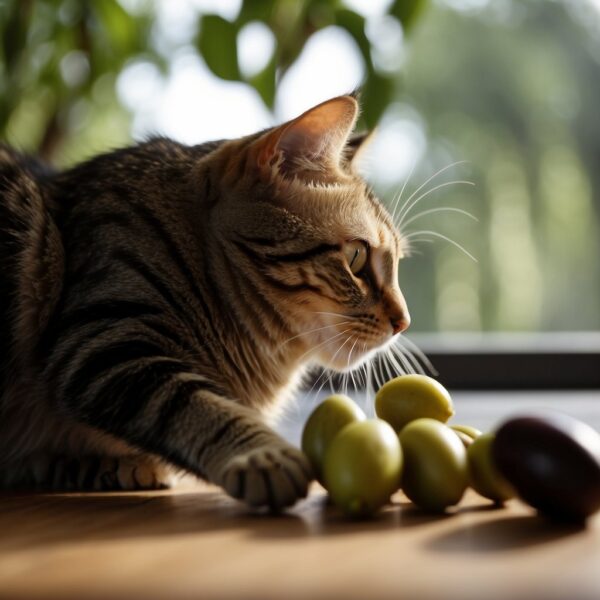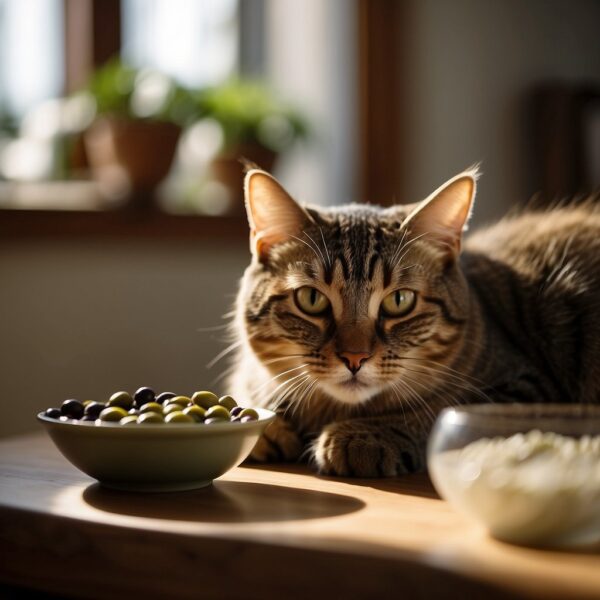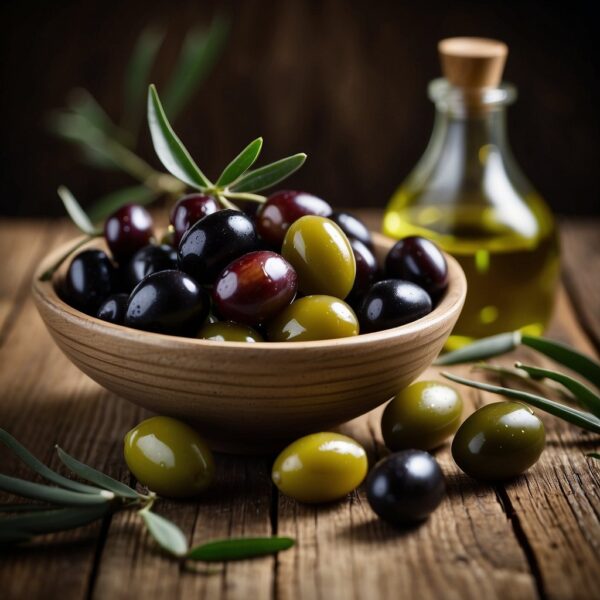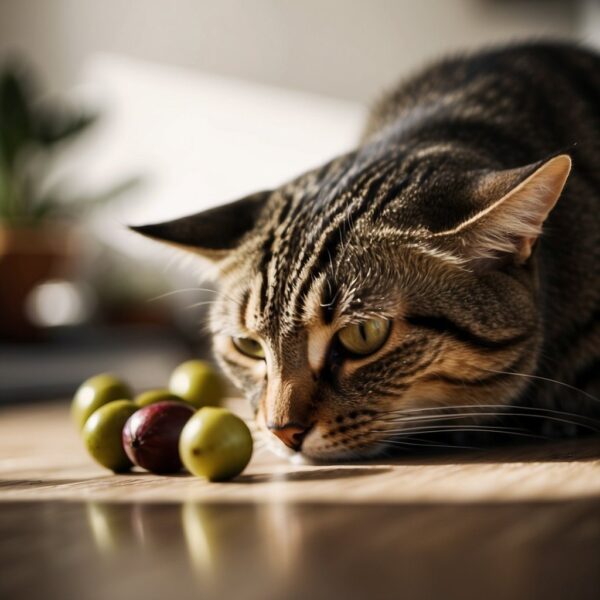
Cats and Olives: The Attraction and the Risks
Cats are curious creatures, often interested in the foods their human companions eat, which prompts some cat parents to wonder if their cat can eat olives. When considering olives, a common item in many kitchens, owners need to understand their effects on cats. While olives are not toxic to cats, they do contain compounds that can provoke a range of responses, from mild interest to digestive issues.
Olives possess both appealing and potentially harmful characteristics for cats. On one hand, olives contain a compound similar to the one found in catnip, which can explain the behavioral attraction some cats have towards them. On the other hand, the high sodium content and the physical risks, like choking hazards from pits, raise concerns. Since olives offer no nutritional benefit to a cat’s diet and can lead to health problems, moderation is essential, and owners should be cautious if choosing to give olives to their pets.
Key Takeaways
- Olives are not toxic to cats but should be given in moderation.
- The high sodium content in olives could lead to health issues for cats.
- Consultation with a veterinarian is advised before incorporating olives into a cat’s diet.

Behavioral and Physiological Responses to Olives
Cats often exhibit a noticeable attraction to olives, which can be attributed to the fruit’s scent and the cats’ physiological reaction to certain compounds. The responses can range from benign curiosity to playful behavior.
The Attraction of Cats to Olives
Many cats are drawn to olives due to their scent, which may resemble the aroma of catnip, a plant well-known for its effect on feline behavior. The compound responsible for the reaction cats show to catnip is called nepetalactone. Although olives do not contain nepetalactone, they do have compounds that could trigger a similar behavioral response in cats. This reaction is typically characterized by:
- Playful actions such as batting or chasing the olive.
- Sniffing or licking the olive with apparent interest.
- Showing signs of a temporary uplift in mood or energy, interpreted by some as a “silly” or altered state.
These reactions suggest that olives may have a component that mimics the mind-altering effects of catnip, leading to an observable change in normal cat behavior.
Responses Mediated by the Vomeronasal Organ
Cats possess a specialized sensory system known as the vomeronasal organ, also referred to as Jacobson’s organ. This organ detects pheromones and other chemicals that are not picked up by the cat’s main olfactory system. When a cat encounters olives:
- The scent of olives may stimulate the vomeronasal organ.
- It leads to a physiological response where the cat analyzes the scent and reacts to it.
Because this organ is pivotal in interpreting pheromones, olives might contain certain compounds that mimic the effects of pheromones, thus influencing cat behavior. When cats exhibit an interest in olives, they might be experiencing a form of chemosensory communication, akin to detecting pheromones. The observable behaviors could be a direct result of the compounds processed by the vomeronasal organ.

Health Implications of Cats Eating Olives
When considering permitting your cat eating olives, one should weigh both the potential health benefits and the risks. Olives are not toxic to cats, but they are not a necessary part of their diet either. There is no reason to feed your cat olives.
Benefits of Olives for Cats
- Vitamin E and Antioxidants: Olives contain vitamin E and antioxidants, which can support a cat’s immune system.
Potential Risks and Negative Effects for cats eating olives
- High Sodium Content: Olives, especially those that are canned or pickled, have high sodium levels, which can lead to sodium toxicity in cats.
- Fat Content: While containing healthy fats, olives are high in fat, and excessive fat can contribute to weight gain and obesity in cats, potentially leading to more serious health issues like kidney disease.
- Choking Hazard: Olives may pose a choking risk, particularly for smaller or more voracious cats.
- Possible Upset Stomach: Cats’ digestive systems are not adapted for olives, and they may cause gastrointestinal upset.

Olives and Their Properties
Olives, the fruit of the Olea europaea tree, offer a distinct nutritional profile and host various chemical compounds that contribute to their health benefits.
Nutritional Profile of Olives
Olives are a significant source of healthy fats, primarily monounsaturated fat in the form of oleic acid. They are low in sugar and provide dietary fiber, which aids in digestion. Olives also contain a modest amount of vitamins and minerals, including vitamin E, vitamin A, calcium, copper, and iron. Small amounts of sodium can be found in olives as well, especially those that are brined or cured.
Here is a table summarizing their nutritional components per 100 grams:
| Nutrient | Amount |
|---|---|
| Fat | 11-15 grams |
| Sodium | 1-2 grams |
| Fiber | 1-3 grams |
| Sugar | 0 grams |
| Vitamin A | 3-4% DV |
| Vitamin E | 20-25% DV |
| Calcium | 1-3% DV |
| Copper | 4-5% DV |
| Iron | 4-8% DV |
(DV = Daily Value)
Components and Chemical Compounds in Olives
The health benefits of olives can be attributed to their rich composition of chemical compounds such as antioxidants like oleuropein, hydroxytyrosol, tyrosol, and quercetin. These antioxidants fight oxidative stress and may contribute to the prevention of chronic diseases. Apart from antioxidants, olives contain anti-inflammatory and antimicrobial properties that further bolster their health-promoting qualities.
Each olive component plays a role in its overall profile:
- Oleic Acid: A monounsaturated fatty acid linked to heart health.
- Oleuropein: An antioxidant that may reduce inflammation and cholesterol.
- Hydroxytyrosol: A potent antioxidant, supports brain health.
- Tyrosol: An antioxidant that might protect against certain diseases.
This detailed breakdown outlines why olives are not just tasty but also potentially beneficial to human health.
Safety Considerations for Cats and Olives
When considering offering olives to cats, safety should be the foremost concern. It is essential to be aware of the potential risks olives pose to felines, such as choking hazards, toxic ingredients, and dietary implications.
Choking Hazards and Olive Pits
Olives come in different varieties, including green and black olives. One common hazard associated with olives is the presence of pits, which can pose a significant choking hazard to cats. Cats might not distinguish between the olive flesh and the pit, leading to possible choking incidents.
- Green olives and black olives: Both can contain pits.
- Choking risk: Olive pits are rightly sized to cause obstruction in a cat’s small throat.
Toxic Ingredients in Prepared Olives
Prepared olives often contain additives that are harmful to cats. Ingredients like garlic and onions, which are sometimes used in stuffed olives with pimentos, are toxic to cats. Additionally, the sodium content in olives can be detrimental to a cat’s health if consumed in large amounts.
- Toxic ingredients: Garlic, onions
- Harmful additives: High sodium content
Proper Serving Suggestions
If a guardian decides to let their cat consume olives, it should be in small quantities as an occasional treat. Olives should never be a staple in a cat’s diet and should be offered with caution.
- Moderation: Only in small amounts
- Occasional treat: Not a regular part of the diet
Feeding olives to cats should always be done thoughtfully, considering these safety concerns to avoid any health issues.
Understanding Cats and Their Dietary Needs
Cats have specific dietary needs that align with their biological makeup as obligate carnivores. This section dissects the essential nutrients required for their health and the human foods that are safe or unsafe for feline consumption.
Obligate Carnivores and Their Nutritional Requirements
Cats, as obligate carnivores, possess a physiological need for meat. They derive their essential nutrients from animal-based proteins and fats. Their nutritional requirements include:
- High protein: Protein from meat is critical for muscle maintenance and growth.
- Taurine: An amino acid found only in animal tissue, vital for heart and eye health.
- Arachidonic acid: A fatty acid essential for reproductive and skin health.
- Vitamin A: Unlike humans, cats cannot convert beta-carotene from plants into vitamin A and must consume it directly from animal sources.
- Niacin: Cats require preformed niacin in their diet as they cannot synthesize it in sufficient quantities from tryptophan.
Common Human Foods That Cats Can and Cannot Consume
While cats primarily thrive on a diet tailored to their carnivorous nature, they occasionally show interest in human foods. Here is a brief outline of what they can and cannot consume:
- Safe in moderation:
- Cooked lean meats (chicken, turkey, and beef)
- Cooked eggs
- Certain cooked fish (avoiding those high in mercury)
- Unsafe and should be avoided:
- Chocolate and caffeinated beverages
- Onions and garlic
- Grapes and raisins
- Alcoholic beverages
- Dairy products as many cats are lactose intolerant
Olives, although not toxic, offer no nutritional benefits to cats and should only be considered an occasional treat, without the pits to prevent choking hazards.
Consulting a Veterinarian
When considering adding olives to a cat’s diet, consulting with a veterinarian is crucial. Although olives are not inherently toxic to cats, a veterinarian can provide tailored advice on whether they are safe and appropriate for an individual cat’s health and dietary needs.
- Safety: A veterinarian can assess if a cat has any pre-existing conditions that could be exacerbated by olives, such as tendencies for diarrhea or vomiting.
- Portion Control: They can recommend appropriate portion sizes to avoid the risks associated with overconsumption.
Here are some specific reasons to consult a veterinarian:
- Allergic Reactions: Cats can sometimes develop allergies to new foods. A veterinarian can inform the owner about the signs of adverse reactions.
- Sodium Content: Olives contain sodium, which in excess can lead to health issues. A veterinarian can guide owners on lower-sodium options.
- Digestive Health: They can advise if a cat’s digestive system can handle olives without causing gastrointestinal upset.
- Choking Hazards: For safety, veterinarians can advise on the proper way to serve olives to avoid choking, especially concerning the pits.
Veterinary care is also pivotal in cases where a cat inadvertently consumes large quantities of olives, as they can quickly discern symptoms of sodium toxicity and take appropriate action. In any case, a veterinarian is the best resource for maintaining a cat’s overall health when introducing any human food into their diet.
Cats and olives: Incorporating Olives Into a Cat’s Diet
Introducing olives or olive oil into a cat’s diet must be approached with caution. Moderation is essential, and cat parents should ensure that these items do not constitute a significant part of the daily caloric intake.
Olive Oil as a Dietary Supplement for Cats
Olive oil can be a beneficial supplement for a cat’s diet when used sparingly. It is high in monounsaturated fats, which can help maintain a healthy coat and skin. However, due to its high caloric content, olive oil should be given in small quantities—typically no more than a teaspoon for an average-sized cat—to avoid the risk of obesity. Always introduce any supplement gradually to monitor for any adverse reactions.
- Usage: A few drops to a teaspoon mixed in food.
- Frequency: Not daily; once a week or as advised by a vet.
- Benefits: Improved skin and coat condition.
Practical Tips for Offering Olives as Treats
When offering olives as treats, ensure they are plain, unsalted, and free from any harmful additives like garlic or onions. The pits should also be removed to prevent choking hazards. Since treats should compose only a small fraction of a cat’s daily calories, limit olive treats to one or two small pieces on occasion.
- Selecting Olives: Choose plain, pitted olives.
- Serving Size: No more than 1-2 small pieces.
- Frequency: Infrequently, as a small part of treat time.
Interaction during treat time can strengthen the bond between a cat and its owner, but olives should not replace specially formulated cat treats that are tailored to feline nutrition. Including olives in salads or other human foods is not suitable for cats, especially if they are marinated or dressed in ingredients that may be toxic to felines. Always count olives as part of the daily caloric intake to maintain a balanced diet.

Frequently Asked Questions about cats eating olives
In this section, answers to common questions regarding the safety and implications of cats eating olives are provided, drawing from accurate, vet-reviewed information.
Are pimento-stuffed olives safe for feline consumption?
Pimento-stuffed olives are not toxic to cats, but due to their high sodium content and potential additives, they should be offered only sparingly and in small amounts.
Is it okay to feed my cat raw olives?
Raw olives are safe for cats to eat in moderation. However, they provide no nutritional benefit to felines and should be treated as an occasional snack.
Could olives cause psychoactive effects in cats?
Olives contain a compound similar to nepetalactone found in catnip, which may cause a mild psychoactive effect in some cats, typically manifesting as playful behavior.
Is ingesting olive seeds harmful to cats?
Olive seeds can be a choking hazard and may cause intestinal blockage if ingested. It is best to remove the pits before offering olives to cats.
Can olive juice pose any health risks to cats?
Olive juice, being high in sodium and potentially containing other seasonings, can pose a health risk to cats if consumed in significant quantities. It should generally be avoided.
Are kalamata olives a safe variety for cats to eat?
Kalamata olives, like other olive varieties, are not hazardous to cats, but due to their high salt content, they should only be given as a rare treat and in very small portions.